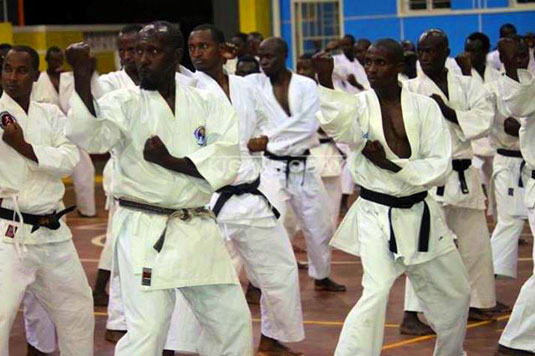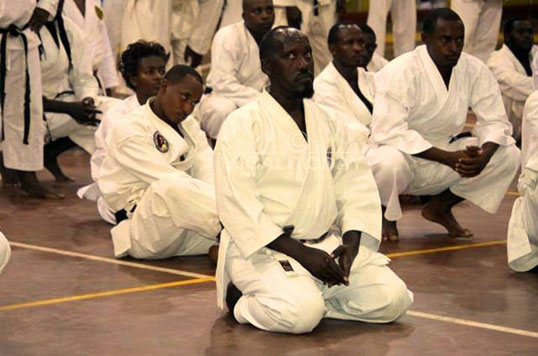
2nd left- Sinzi Tharcisse a Karate black belt holder, He mobilised thousands of Tutsi to resist Interahamwe
More than 100 survivors owe their lives to one Karate fighter Sinzi Tharcisse. He mobilised thousands of Tutsi to resist Interahamwe that attacked their hiding place at the Institute of Agronomic Sciences of Rwanda (ISAR) Songa in the former Rusatira commune, Butare prefecture (Now Southern Province).
For his outstanding skills to save lives, Sinzi was later to be nicknamed ‘April Father’.
Kayitesi Clementine was 9 years old, when the genocide against Tutsi began in 1994. She lost her parents and her six brothers in the tragedy that claimed more than a million lives in just 100 days.
On April 12, as the Genocide escalated, Kayitesi met Sinzi at ISAR- both were fleeing to save their lives.
More than 3400 Tutsis gathered at ISAR Songa including many from neighbouring places including; Sazange, Rukamira and Ruyenzi. They thought this largely farming place was a safe haven.
Among this crowd, however, was Sinzi Tharcisse a humble young man – he was a professional Karate practitioner and held a black belt.
By then Sinzi was aged 32, he started mobilising people and showing them how they could resist Interahamwe that were targeting to kill them.
“I taught those who were with me some self-defense techniques using my Karate skills. I asked them to be strong and brave,” Sinzi told Kigali Today. The hiding group developed trust in him and started issuing orders and instructions to the group.
Philippe Ndayisaba, one of survivors of Songa massacre, recalls one of the techniques. “I remember one day telling (Sinzi) that if I find any man busy cooking or looking after his cattle, I would get angry with him. Pick up everything that could be seen nearby, we have to fight,” narrates Ndayisaba.
According to Sinzi, whenever the interahamwe attempted to approach them, they would stone them and beat or chase them using other traditional weapons. They resisted for a week till the day they heard an announcement from the national radio saying RPA had taken over Songa hill, and were the ones fighting the interahamwe.
Kayitesi remembers that one day children were too thirsty, “We tried to go and ask for milk. Surprisingly when we got out of hiding, we found French with Rwandan soldiers who gave us milk, but also asked us how many we were on the other side.”
The soldiers had something else in mind – to exterminate them.
“Since we heard that announcement on Radio, I told people that things are becoming worse that they must start moving. They first resisted thinking they could not leave their cattle. Others were Christians and said God will save them because nobody can kill a big number of people,” recalls Sinzi.
On April 27, Interahamwe invaded their hiding place bombing them with heavy weapons that were installed at ‘Arrete’ – an adjacent hill and the helicopter hovered over making sure nobody escaped.
“Interahamwe were after me. I heard news saying that they have to take out my heart and head to show everybody I was dead, but we continued fighting,” said Sinzi.
“You could be standing with people and see their heads, intestines, arms and legs down. It was really terrifying,” Kayitesi remembers.

Sinzi Tharcisse, is scheduled for recognition as national hero
Successful techniques
On the same day Sinzi commanded survivors of this massacre and walked through barriers to reach Akanyaru river and susseffuly crossed to neighbouring Burundi.
For instance, on April 28, when they were attempting to cross a barricade near Mwogo River, they separated and some went through Kinyamakara commune in former Gikongoro prefecture, while others moved away interahamwe by throwing stones at them. The militias would see stones in the air and think they were gunshots – hence prompting them to withdraw and pave way for escape.
One of Sinzi’s other technique, he recalls, was that when they planned to cross Akanyaru River at the border with Burundi, he crossed first by swimming. When he crossed and reached at the shore, he told boat sailors that there are people with much money on the other side who needed transport.
“Of course, we had nothing. But by 5:00 am in the morning, none of us was left on the Rwandan side. We paid them what we had such as clothes and some little money,” said Albert Mugabo, one of the survivors.
Saved by one man
Sinzi had applied all his Karate techniques to save fellow Tutsi during the genocide, but lacked enough talented manpower. Many of them were killed.
According to him Among 2480 that were with Sinzi at the beginning; only 118 survived from the genocide against Tutsi.Once in Burundi, those who survived and crossed Akanyaru River were taken to a refugee camp called Bunnyari near Kirundo province.
According to survivors, Sinzi continued taking care of them by taking them to the hospital for medical care.
Sinzi, now 55, is proud of saving lives of people. He lost his parents and his wife and child during the genocide.When the genocide started, he was serving at the former National University of Rwanda.
After his family was killed in Butare, he fled to Rusatira – his native place to see if his parents were still alive. Unfortunately it was too late. He immediately run to Songa hill.
Today, Sinzi described as ‘Master Sinzi’ (Maitre Sinzi), resumed work at the University of Rwanda’s college of arts where he serves as the Director of Estates.In the eyes of Rwandans, he is a ‘Hero’.
The Chancellery for Heroes, National Orders and Decorations of Honor (CHENO) is planning to recognise Sinzi Tharcisse among national heroes to recognize officially for his unmatched bravery and humanity.
“He is what I can’t describe with my words. If possible, i look forward to the day he will be named a hero,” Said 60-year-old Albert Mugabo, one of the survivors.

